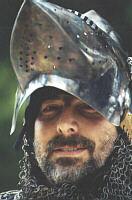Journal of Western Martial Art
Volume 2001
Archived Articles
| 12/01 | Deborah Klens-Bigman, Ph.D. - "How's your elephant?" An Asian style Martial Artist looks at the WMAW
Rapiers, daggers, broadswords, knights in shining suits of armor - stuff of childhood fantasies. As a kid, I would have killed (or at least fought a duel) for a chance to attend the Association for Historical Fencing's Third Annual Western Martial Arts Workshop, held October 12, 13 and 14, 2001, at Riverside Church, in New York City. |
| 05/01 | Frank Docherty - A Brief History of the Quarterstaff
The Quarterstaff was for centuries considered the weapon of the lower sections of society, although the nobility had a healthy respect for the Quarterstaff, which they also practised. In reality Quarterstaffing, as a fighting art reigned supreme in England for many centuries. |
| 04/01 | Grzegorz Zabinski - Several Remarks on the Blossfechten Section of Codex Wallerstein
The paper deals with selected aspects of Blossfechten (unarmoured combat) with the longsword as depicted in one of the most renowned, yet still unpublished source of medieval swordsmanship known as Codex Wallerstein (Universitaetsbibliothek Augsburg, I. 6.4o.2). |
| 03/01 | Ken Mondschein - Daggers of the Mind: Towards a Historiography of Fencing
If historians from Karl Marx to Michel Foucault have dealt with conflict between dominant and subordinate groups as a primary theme in their work, it is arguably because of their European background. The notion of social class, it has oft been noted, is more in the fore of the French or British mind than it is in the American. |
| 02/01 | Maestro Ramón Martínez - The Demystification of the Spanish School
The Spanish School of Swordsmanship, "La Destreza" is the most misunderstood subject in the history of fencing. It has been misrepresented by fencing scholars for the past one hundred years as an ineffectual and artificial system of swordsmanship full of absurdities. The intent of this article and others to follow is to present a clearer and more accurate picture of what "La Destreza" is. |
| 02/01 | Ken Mondschein - Getting to the Point: The European Art of Fencing
As with most things in the martial arts, the story of fencing is not a simple one. If you ask one person to tell you what "fencing" is, he might tell you that it's a modern sport. Ask a second, and she might describe fencing as a five-hundred-year-old martial tradition. |
| 02/01 | Peter Kautz - Fiore dei Liberi's 7 Rules of Wrestling
In his 1410 book Flos Duellatorum (The Flower of Battle) Fiore tells us that in his time he met "1000 men who would call themselves masters; though if their skills were combined, you would not have 4 good students, let alone one True Master", and that he wrote his book at the end of his life because there was simply no one around who was as skilled as he was, or who knew so many kinds of techniques. |
Feedback
You are welcome to contact the editor, David Cvet with or to submit via email, "". Letters to the editor will be published in the above listing in a similar fashion as articles submitted.
Please include your name, city, prov/state with your letter and indicate whether or not your email addy can be included in your letter online.
Resources
- You can find more information on medieval fighting arts at the Academy of European Medieval Martial Arts website or to view an extensive online library of medieval fighting arts treatises visit the AEMMA Online Library.
The Editors
, Executive Editor - JWMA and JManly
David is the Founder and President of the Academy of European Medieval Martial Arts (AEMMA), an organization dedicated to the resurrection and formalization of medieval martial arts training systems. He received training in Milan, Italy employing steel weapons in longsword techniques and has participated in various organizations dedicated to studying the Middle Ages. His background and experience having fired his desire to pursue a formal medieval martial arts training program, he founded AEMMA in mid-1998. He is a member of the advisory board of the Swordplay Symposium International (SSI), an interdisciplinary colloquium of historical fencing specialists dedicated to promoting and advancing the study of Western swordsmanship, and participating board member of the Association for Historical Fencing (AHF). David received his appointment of free scholler in Oct, 2000 and the "Acknowledged Instructor" (AI) designation for armoured combat instruction in Oct, 2000 by the International Masters at Arms Federation (IMAF).
, Editor - JManly
Tony is a professional fight director and martial arts/stage combat tutor. Since 1978 he has traversed a wide range of Asian, Polynesian and European martial arts, with a particular interest in both European "folk styles" and the combatives of the late 1800s. He was a pioneer of padded-attacker self-defence training in his home country of New Zealand and serves as an advisor for several international martial arts and stage combat organisations.
Tony's fight direction and action sequences have been featured in over one hundred and seventy feature film, television, theatre, opera and ballet productions. Between 1998-2000 he served as the Fighting Styles Designer for Peter Jackson's Lord of the Rings movie trilogy and in 2002 he toured Japan with the Washington Opera Company's production of Otello starring Placido Domingo. Tony has taught, directed and performed throughout New Zealand, as well as in Australia, the USA, England, Ireland, Canada and Japan. He lives in Wellington, New Zealand with his son, Josh.
EJMAS Copyright © 2003 All Rights Reserved ISSN 1492-1642

